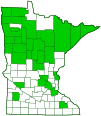veiny meadow-rue
(Thalictrum venulosum)
Conservation • Wetland • Description • Habitat • Ecology • Use • Distribution • Taxonomy
Conservation Status |
|
|||||||
| IUCN Red List | not listed |
|||||||
| NatureServe | NNR - Unranked SNR - Unranked |
|||||||
| Minnesota | not listed |
|||||||
Wetland Indicator Status |
||||||||
| Great Plains | FAC - Facultative |
|||||||
| Midwest | FAC - Facultative |
|||||||
| Northcentral & Northeast | FACW - Facultative wetland |
|||||||
Description |
||
Veiny meadow-rue is a 12″ to 40″ tall, erect, perennial forb that rises from the upturned end of a rhizome. Staminate flowers (male) and pistillate flowers (female) are borne on separate plants. Stems are erect, hairless or nearly hairless. Stem leaves are alternate. Stem leaves below the inflorescence are on leaf stalks. Those subtending the inflorescence branches are stalkless. They are 3 or 4 times ternately compound—divided into 3 main divisions (ternate), each division further divided into 3 segments (biternate), each segment further divided into 3 leaflets (triternate), or once more divided. The leaflets are ⅓″ to 1¾″ wide and wider than long. They are round or inversely egg-shaped with the attachment at the narrow end. The leaflets have round-toothed lobes. The upper surface is hairless. The lower surface is hairless but has short, rounded, nipple-like glandular bumps or projections. The inflorescence is a dense, narrow, cluster with ascending branches that appears at the end of the stems and branches. Male flowers have 5 greenish-white, spreading, petal-like sepals. There are no petals. They droop at the end of short stalks. The sepals often drop off early leaving about 12 stamens with colored, not white, filaments and anthers. The flowers do not produce petals or nectar to attract insects. They are wind pollinated. The fruit is an achene about ⅛″ long. |
||
Height |
||
12″ to 40″ |
||
Flower Color |
||
Greenish-white |
||
Similar Species |
||
Early meadow-rue (Thalictrum doicum) flowers bloom earlier, April to May. Purple meadow-rue (Thalictrum dasycarpum) is a much taller plant, 3′ to 5′ at maturity. Middle and upper leaves are stalkless. The leaflets are as long as wide, or, more commonly, longer than wide. The leaflet lobes are untoothed or occasionally have a few additional teeth. Waxy leaf meadow-rue (Thalictrum revolutum) stems are glaucous. Leaflet margins are rolled backward to the underside. The lower leaflet surface is covered with glandular hairs giving it a whitish, waxy appearance, and has a conspicuous network of raised veins. |
||
Habitat |
||
Wet to moderate moisture. Forests, shores, river banks, stream banks. Full to partial sun. |
||
Ecology |
||
Flowering |
||
June to July |
||
Pests and Diseases |
||
|
||
Use |
||
|
||
Distribution |
||||
|
Sources |
|||
| 7/1/2023 | ||||
Nativity |
||||
Native |
||||
Occurrence |
||||
|
||||
Taxonomy |
|||
| Kingdom | Plantae (Plants) | ||
| Division | Tracheophyta (Vascular Plants) | ||
| Subdivision | Spermatophytina (Seed Plants) | ||
| Class | Magnoliopsida (Dicots) | ||
| Superorder | Ranunculanae | ||
Order |
Ranunculales (Buttercups, Poppies, and Allies) | ||
Family |
Ranunculaceae (Buttercup) | ||
| Subfamily | Thalictroideae (columbines and meadow-rues) | ||
Genus |
Thalictrum (meadow-rues) | ||
Minnesota’s veiny meadow rue has been classified as Thalictrum venulosum, Thalictrum venulosum var. confine, or sometimes Thalictrum confine. The names were used inconsistently. A study (Mitchell, 1988) was conducted in an attempt to resolve the longstanding confusion. T. confine was traditionally distinguished from T. venulosum by the larger fruit that is hooked at the top (falcate). The study determined that the fruits were variable and close enough in morphology as to not warrant separation. The author chose to recognize a single variable (polymorphic) species, T. venulosum. |
|||
Subordinate Taxa |
|||
|
|||
Synonyms |
|||
Thalictrum confine Thalictrum confine var. columbianum Thalictrum confine var. greeneanum Thalictrum occidentale var. columbianum Thalictrum turneri Thalictrum venulosum var. confine Thalictrum venulosum var. fissum Thalictrum venulosum var. lunellii Thalictrum venulosum var. turneri |
|||
Common Names |
|||
boundary meadow-rue early meadowrue northern meadow-rue veiny meadowrue veiny meadow-rue veiny-leaf meadow-rue |
|||
Glossary
Achene
A dry, one-chambered, single-seeded seed capsule, formed from a single carpel, with the seed attached to the membranous outer layer (wall) only by the seed stalk; the wall, formed entirely from the wall of the superior ovary, does not split open at maturity, but relies on decay or predation to release the contents.
Glandular hairs
Hairs spread over aerial vegetation that secrete essential oils. The oils act to protect against herbivores and pathogens or, when on a flower part, attract pollinators. The hairs have a sticky or oily feel.
Glaucous
Pale green or bluish gray due to a whitish, powdery or waxy film, as on a plum or a grape.
Rhizome
A horizontal, usually underground stem. It serves as a reproductive structure, producing roots below and shoots above at the nodes.
Ternate
Refers to leaves that are divided into three leaflets or sections.
Visitor Photos |
|||||
Share your photo of this plant. |
|||||
| This button not working for you? Simply email us at info@MinnesotaSeasons.com. Attach one or more photos and, if you like, a caption. |
|||||
|
|||||
MinnesotaSeasons.com Photos |
|||||
|
|||||

Slideshows |
||

Visitor Videos |
|||
Share your video of this plant. |
|||
| This button not working for you? Simply email us at info@MinnesotaSeasons.com. Attach a video, a YouTube link, or a cloud storage link. |
|||
Other Videos |
|||

Visitor Sightings |
|||||
Report a sighting of this plant. |
|||||
| This button not working for you? Simply email us at info@MinnesotaSeasons.com. Be sure to include a location. |
|||||
|
|||||
MinnesotaSeasons.com Sightings |
|||||

|
Created: Last Updated: © MinnesotaSeasons.com. All rights reserved. |
